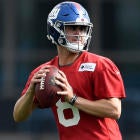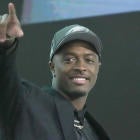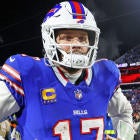Everyone wants to know about instant impact rookies, and I get it. We live in an instant gratification society, and early picks are essentially expected to produce in a big way, well, instantly.
But not all have to immediately assert themselves as stars to ultimately have success at the NFL level. Some, frankly, need a "redshirt" season.
Below are the players picked in the first or second round of the 2019 NFL Draft who most need time to develop before being thrust into the NFL spotlight.
For the sake of this article, the term "redshirt" isn't exactly meant to have the same definition as it does it college -- a player sitting out an entire season. For a few of these players that could be the case. For others, "redshirt" is simply meant to imply they should have a very limited on-field role as a rookie while they fine-tune their skills and/or add strength in the weight room.
Daniel Jones, QB, Giants
Redshirt need: Moderate
Likelihood of redshirt: Significant
Jones's redshirt need is only moderate because to me, if Pat Shumur was forced into a situation in which Jones had to operate his West Coast offense as a rookie, I think he could do it. How effective would he be? Well that's another question with a different answer. Jones has good footwork, can get through his reads somewhat quickly, and flashed anticipatory passing skills in his final season at Duke.
His accuracy to all levels and play under pressure leaves a lot to be desired, as does his decision-making, the latter of which being the main reason he needs a season -- yes, a full season -- holding the clipboard. Can the accuracy issues be coached out of him? It rarely happens with quarterbacks. Learning to scale back risky throws and off-balance tosses? Much more likely to happen.
Will Jones learn to not do those things while watching Eli Manning? Maybe. But it's not like Eli will be setting the best example in those facets of playing the quarterback position.
Rashan Gary, EDGE, Packers
Redshirt need: Significant
Likelihood of redshirt: Significant
The Gary pick by Green Bay confused me more than any other in the first round of the 2019 NFL Draft. For real. The Packers spent $36M in full guarantees on Za'Darius Smith ($20M, 18th-highest among edge rushers) and Preston Smith ($16M, 25th-highest among edge rushers), players who, like Gary, are hybrid edge rushers and defensive linemen.
Just the money given to the Smiths alone will stand as a reason Gary will have a difficult time seeing the field very often at all in 2019. Then, factor in his extremely limited arsenal of pass-rush moves/plans, and this seems like the perfect marriage of redshirt need and likelihood of it happening, provided the Packers don't slot him in as a five-technique end to get him on the field immediately.
Dwayne Haskins, QB, Redskins
Redshirt need: Significant
Likelihood of redshirt: Minimal
Context of production is more important with Haskins than any other recent top quarterback prospect. It's easy to see 70 percent completions, 50 touchdowns and eight interceptions and think "instant, elite starter." But then context factors in.
Haskins operated a wide-open offense that predominately featured short, high-percentage, YAC-predicated passes to the fastest receiver group in the country -- of all-time? Parris Campbell ran 4.31 in the 40-yard dash. Terry McLaurin ran 4.35. Johnnie Dixon ran 4.41.
Haskins' film shows a willingness to drift away from pressure inside the pocket -- a vital, mastery-level skill at the quarterback spot -- but an inability to effectively do so in most cases because of "slow feet." Also, anticipation throws were very rare. Lastly, Haskins lacks accuracy on downfield throws that require pinpoint ball placement. Watch the Maryland, Penn State, Michigan State, and Indiana games. In Ohio State's impressive Rose Bowl win over Washington, Haskins lit up the stat sheet in the first half, but essentially all of the throws were incredibly simple and/or to wide open receivers. He struggled mightily in the third and fourth quarters.
Haskins needs at least half a season to get faster moving inside the pocket, learning to trust himself to throw the football before receivers come open, and improve his accuracy down the field. Will the presence of Case Keenum be enough to hold off a first-round pick quarterback in Washington? Doubtful, especially if Jay Gruden feels like he's coaching for his job in 2019.
Garrett Bradbury, C, Vikings
Redshirt need: Moderate
Likelihood of redshirt: Minimal
Bradbury is the most athletically gifted top center prospect to join the NFL in a while. On the move, he's insane. But simultaneously, the NC State star is in dire need of added weight and power more so than any of the recent highly sought after centers available in the draft.
At almost 6-foot-3 and just 307 pounds, Bradbury is slight of frame for the position, and his lack of power was evident on film in college, even in his final season in the ACC.
Right away, Bradbury will be regularly capable of reaching three techniques across one gap, thwarting stunts, and blocking linebackers 10 yards down the field on screens. Dealing with a bull rush from Mike Daniels on the Packers or Eddie Goldman on the Bears? That's going to be a problem. Being picked at No. 18 overall to a team needing major offensive line reinforcement likely means Bradbury is bound to start at the pivot as a rookie. A redshirt of any kind is unlikely. Minnesota will just have to get by with his anchoring weakness against power moves and accentuate his exemplary athleticism in the run game and when dealing with twists and delayed blitzes through the A-gap.
Andre Dillard, OT, Eagles
Redshirt need: Significant
Likelihood of redshirt: Significant
Dillard's pass-blocking sets were as clean as any tackles in the class, although he didn't necessarily face a Murderers' Row of edge rushers in the Pac-12. An excellent athlete for the tackle spot with surprising anchoring strength, Dillard rarely if ever looked off-balance or panicked on pass plays at Washington State in his senior season.
But the Cougars called 52.1 passes to just 21.4 runs per game, and a good amount of those rushes were draws up the middle. Dillard simply doesn't have anywhere near the normal amount of experience blocking on run plays for a rookie tackle.
With Jason Peters still in the mix in Philadelphia and Lane Johnson locking down the right side, Dillard is highly unlikely to play instantly. There's actually a decent chance he barely plays his entire rookie season. And that's probably for the best. Then again, Peters is 37 years old, and while he returned to play a full season in 2018 after tearing two knee ligaments in 2017, the quality of his play dipped.
Tytus Howard, OT, Texans
Redshirt need: Significant
Likelihood of redshirt: Minimal
Had the Eagles not traded up ahead of the Texans, Dillard almost assuredly would've landed in Houston and found himself in an entirely different, non-redshirt situation given the Texans' massive need at left tackle.
With Dillard off the board, Houston went with another athletic outside blocker in Howard, but his need for a redshirt year is not just because he went to Alabama State, although the leap in competition has to be considered.
Howard, like Bradbury, must add mass to his frame to combat bull rushes at the next level, arguably the most relied upon pass-rushing move for defensive linemen. He measured in at 6-foot-5 and 322 pounds and plays even lighter than that. Athletically, he's fantastic. Zone runs, screens, combo blocks to the second level, Howard looks the part of a franchise left tackle. Power hurts him, and he didn't have to fight legitimate counter moves from rushers in college, which will no longer be the case at the NFL level.
There's an outside chance Houston's free-agent signee Matt Kalil will start at left tackle in 2019. Or incumbent Julie'n Davenport could begin the season there. Neither provide any hope for competent play at a premium position, and the Texans just used a premium selection on Howard. He'll likely see the field early as a rookie, and while he has the athletic profile and the strong grip to emerge as a high-quality tackle eventually, serious growing pains are imminent.
Drew Lock, QB, Missouri
Redshirt need: Minimal
Likelihood of redshirt: Significant
Throughout the draft process, I often said on radio that Lock was the quarterback in the 2019 class most ready to start an NFL game, for any team/scheme, in Week 1 as a rookie.
I still stand by that, but time on the sidelines would benefit Lock, especially as he backs up Joe Flacco. Why? Lock's footwork and pocket presence greatly improved in his senior season at Missouri, but they're far from perfect. Taking time to calm his feet inside the pocket would do wonders for his success in Year 2 and beyond. The arm strength, full-field reading ability, and accuracy to each level of the field are already there.
Denver acquired Flacco via trade this offseason, but his deal includes no dead cap, so the Broncos can move on from him at essentially any point over the next three years. John Elway needs to get the quarterback position right at this point of his tenure, and taking the methodical approach with the team's second Round 2 pick in the 2019 Draft would be the most prudent way to help to ensure Lock ultimately becomes a legitimate franchise quarterback.
Ben Banogu, EDGE, Colts
Redshirt need: Significant
Likelihood of redshirt: Moderate
Banogu was the second of three Round 2 selections for the Colts, and on the surface, everything checks out with him. At over 6-foot-3 and 250 pounds, he has ideal edge rusher size. In terms of athleticism, the numbers and tape don't necessarily agree. His 40-yard dash was in the 90th percentile. Vertical: 97th percentile. Broad jump: 99th percentile. Three-cone and short shuttle: both in the 80th percentile. Lastly, he was very productive in his two seasons at TCU. He totaled 34.5 tackles for loss and 17 sacks.
While Banogu certainly looks athletic on film, he doesn't appear to be as athletic as his combine figures indicate, and a decent portion of his production was due to a stunt-heavy scheme and the role he played -- at times the unblocked edge rusher on read-option plays.
His pass-rushing arsenal is underdeveloped, he's not super bendy around the corner and needs to improve the power in his bull rush. With the elite athletic gifts, Banogu can ultimately become a vital strongside linebacker in Indianapolis who can cover, set a strong edge, and most importantly, get after the quarterback on a routine basis. He just needs time to refine is game and get stronger.
With Justin Houston added in free agency along with established veteran Jabaal Sheard and 2018 second-round pick Kemoko Turay, who flashed as a rookie, it's not a major necessity that Banogu steps in immediately. But that edge-rusher group isn't super deep, so there's a decent chance he'll take on a relatively sizable role as a somewhat raw outside rusher as a rookie.
















